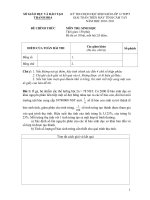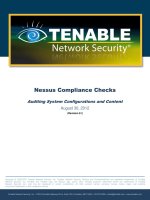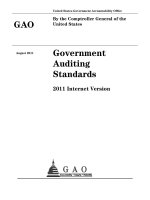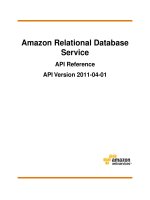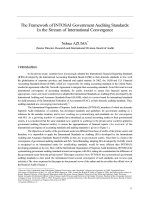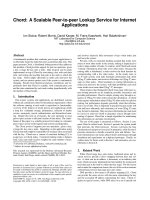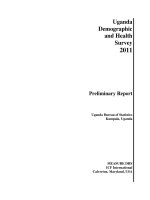Government Auditing Standards 2011 Internet Version pot
Bạn đang xem bản rút gọn của tài liệu. Xem và tải ngay bản đầy đủ của tài liệu tại đây (578.77 KB, 219 trang )
United States Government Accountability Office
By the Comptroller General of the
United States
Government
Auditing
Standards
2011 Internet Version
August 2011
GAO
Government Auditing Standards 2011 Internet Version
i
CONTENTS
CHAPTER 1 1
GOVERNMENT AUDITING: FOUNDATION AND ETHICAL PRINCIPLES 1
Introduction 1
Purpose and Applicability of GAGAS 2
Ethical Principles 4
The Public Interest 5
Integrity 6
Objectivity 6
Proper Use of Government Information, Resources, and Positions 7
Professional Behavior 8
CHAPTER 2 9
STANDARDS FOR USE AND APPLICATION OF GAGAS 9
Introduction 9
Types of GAGAS Audits and Attestation Engagements 9
Financial Audits 10
Performance Audits 13
Nonaudit Services Provided by Audit Organizations 14
Use of Terminology to Define GAGAS Requirements 15
Relationship between GAGAS and Other Professional Standards 17
Stating Compliance with GAGAS in the Auditors’ Report 19
CHAPTER 3 21
GENERAL STANDARDS 21
Introduction 21
Independence 21
GAGAS Conceptual Framework Approach to Independence 23
Threats 25
Safeguards 26
Application of the Conceptual Framework 28
Government Auditors and Audit Organization Structure 30
Government Auditing Standards 2011 Internet Version
ii
External Auditor Independence 30
Internal Auditor Independence 33
Provision of Nonaudit Services to Audited Entities 34
Requirements for Performing Nonaudit Services 34
Consideration of Specific Nonaudit Services 38
Management Responsibilities 40
Preparing Accounting Records and Financial Statements 40
Internal Audit Assistance Services Provided by External Auditors 41
Internal Control Monitoring as a Nonaudit Service 42
Information Technology Systems Services 43
Valuation Services 43
Other Nonaudit Services 44
Documentation 45
Professional Judgment 46
Competence 48
Technical Knowledge 49
Additional Qualifications for Financial Audits and Attestation Engagements 50
Continuing Professional Education 51
CPE Requirements for Specialists 52
Quality Control and Assurance 53
System of Quality Control 53
Leadership Responsibilities for Quality within the Audit Organization 54
Independence, Legal, and Ethical Requirements 55
Initiation, Acceptance, and Continuance of Audits 55
Human Resources 56
Audit Performance, Documentation, and Reporting 56
Monitoring of Quality 57
External Peer Review 58
CHAPTER 4 63
STANDARDS FOR FINANCIAL AUDITS 63
Introduction 63
Additional GAGAS Requirements for Performing Financial Audits 63
Auditor Communication 64
Previous Audits and Attestation Engagements 65
Fraud, Noncompliance with Provisions of Laws, Regulations, Contracts, and Grant
Agreements, and Abuse 65
Developing Elements of a Finding 66
Audit Documentation 68
Additional GAGAS Requirements for Reporting on Financial Audits 69
Reporting Auditors’ Compliance with GAGAS 70
Government Auditing Standards 2011 Internet Version
iii
Reporting on Internal Control and Compliance with Provisions of Laws, Regulations,
Contracts, and Grant Agreements 70
Communicating Deficiencies in Internal Control, Fraud, Noncompliance with
Provisions of Laws, Regulations, Contracts, and Grant Agreements, and Abuse 71
Deficiencies in Internal Control 72
Fraud, Noncompliance with Provisions of Laws, Regulations, Contracts, and Grant
Agreements, and Abuse 72
Presenting Findings in the Auditors’ Report 73
Reporting Findings Directly to Parties Outside the Audited Entity 74
Reporting Views of Responsible Officials 75
Reporting Confidential and Sensitive Information 77
Distributing Reports 78
Additional GAGAS Considerations for Financial Audits 79
Materiality in GAGAS Financial Audits 80
Early Communication of Deficiencies 80
CHAPTER 5 81
STANDARDS FOR ATTESTATION ENGAGEMENTS 81
Introduction 81
Examination Engagements 82
Additional Field Work Requirements for Examination Engagements 82
Auditor Communication 82
Previous Audits and Attestation Engagements 83
Fraud, Noncompliance with Provisions of Laws, Regulations, Contracts, and Grant
Agreements, and Abuse 84
Developing Elements of a Finding 85
Examination Engagement Documentation 87
Additional GAGAS Reporting Requirements for Examination Engagements 88
Reporting Auditors’ Compliance with GAGAS 89
Reporting Deficiencies in Internal Control, Fraud, Noncompliance with Provisions of
Laws, Regulations, Contracts, and Grant Agreements, and Abuse 89
Deficiencies in Internal Control 90
Fraud, Noncompliance with Provisions of Laws, Regulations, Contracts, and Grant
Agreements, and Abuse 90
Presenting Findings in the Examination Report 92
Reporting Findings Directly to Parties Outside the Audited Entity 92
Reporting Views of Responsible Officials 93
Reporting Confidential and Sensitive Information 95
Distributing Reports 96
Additional GAGAS Considerations for Examination Engagements 98
Materiality in GAGAS Examination Engagements 98
Government Auditing Standards 2011 Internet Version
i
v
Early Communication of Deficiencies 99
Review Engagements 99
Additional GAGAS Field Work Requirements for Review Engagements 99
Communicating Significant Deficiencies, Material Weaknesses, Instances of Fraud,
Noncompliance with Provisions of Laws, Regulations, Contracts, and Grant
Agreements, and Abuse 100
Additional GAGAS Reporting Requirements for Review Engagements 100
Reporting Auditors’ Compliance with GAGAS 101
Distributing Reports 101
Additional GAGAS Considerations for Review Engagements 102
Establishing an Understanding Regarding Services to be Performed 103
Reporting on Review Engagements 103
Agreed-Upon Procedures Engagements 104
Additional GAGAS Field Work Requirements for Agreed-Upon Procedures
Engagements 104
Communicating Significant Deficiencies, Material Weaknesses, Instances of Fraud,
Noncompliance with Provisions of Laws, Regulations, Contracts, and Grant
Agreements, and Abuse 105
Additional GAGAS Reporting Requirements for Agreed-Upon Procedures
Engagements 105
Reporting Auditors’ Compliance with GAGAS 106
Distributing Reports 106
Additional GAGAS Considerations for Agreed-Upon Procedures Engagements
107
Establishing an Understanding Regarding Services to be Performed 108
Reporting on Agreed-Upon Procedures Engagements 108
CHAPTER 6 110
FIELD WORK STANDARDS FOR PERFORMANCE AUDITS 110
Introduction 110
Reasonable Assurance 110
Significance in a Performance Audit 111
Audit Risk 111
Planning 112
Nature and Profile of the Program and User Needs 114
Government Auditing Standards 2011 Internet Version
v
Information Systems Controls 120
Provisions of Laws, Regulations, Contracts, and Grant Agreements, Fraud, and Abuse
123
Provisions of Laws, Regulations, Contracts, and Grant Agreements 123
Fraud 124
Abuse 125
Ongoing Investigations and Legal Proceedings 126
Previous Audits and Attestation Engagements 126
Identifying Audit Criteria 127
Identifying Sources of Evidence and the Amount and Type of Evidence Required 127
Using the Work of Others 128
Assigning Staff and Other Resources 129
Communicating with Management, Those Charged with Governance, and Others 130
Preparing a Written Audit Plan 132
Supervision 133
Obtaining Sufficient, Appropriate Evidence 133
Appropriateness 134
Sufficiency 137
Overall Assessment of Evidence 138
Developing Elements of a Finding 140
Early Communication of Deficiencies 141
Audit Documentation 141
CHAPTER 7 144
REPORTING STANDARDS FOR PERFORMANCE AUDITS 144
Introduction 144
Reporting 144
Report Contents 145
Objectives, Scope, and Methodology 146
Reporting Findings 147
Deficiencies in Internal Control 149
Fraud, Noncompliance with Provisions of Laws, Regulations, Contracts, and Grant
Agreements, and Abuse 150
Reporting Findings Directly to Parties Outside the Audited Entity 151
Conclusions 152
Recommendations 152
Reporting Auditors’ Compliance with GAGAS 153
Reporting Views of Responsible Officials 154
Reporting Confidential and Sensitive Information 155
Distributing Reports 156
Government Auditing Standards 2011 Internet Version
v
i
APPENDIX I 158
SUPPLEMENTAL GUIDANCE 158
Introduction 158
Overall Supplemental Guidance 158
Internal Control 159
Examples of Deficiencies in Internal Control 160
Examples of Abuse 162
Examples of Indicators of Fraud Risk 163
Determining Whether Laws, Regulations, and Provisions of Contracts and Grant
Agreements Are Significant within the Context of the Audit Objectives 164
Information to Accompany Chapter 1 166
Laws, Regulations, and Other Authoritative Sources That Require Use of GAGAS 166
The Role of Those Charged with Governance 168
Management’s Role 169
Information to Accompany Chapter 2 170
Attestation Engagements 170
Performance Audit Objectives 171
GAGAS compliance statements 174
Information to Accompany Chapter 3 175
Threats to Independence 175
System of Quality Control 180
Peer Review 184
Information to Accompany Chapter 6 185
Types of Criteria 186
Types of Evidence 187
Appropriateness of Evidence in Relation to the Audit Objectives 187
Findings 189
Information to Accompany Chapter 7 190
Report Quality Elements 190
APPENDIX II 194
GAGAS CONCEPTUAL FRAMEWORK FOR INDEPENDENCE 194
APPENDIX III 195
COMPTROLLER GENERAL’S ADVISORY COUNCIL ON GOVERNMENT
AUDITING STANDARDS 195
Government Auditing Standards 2011 Internet Version
v
ii
Advisory Council Members: 195
GAO Project Team: 199
INDEX 200
Government Auditing Standards 2011 Internet Version
1
Chapter 1
Government Auditing: Foundation and Ethical Principles
Introduction
1.01 The concept of accountability for use of public resources and government authority
is key to our nation’s governing processes. Management and officials entrusted with
public resources are responsible for carrying out public functions and providing service
to the public effectively, efficiently, economically, ethically, and equitably within the
context of the statutory boundaries of the specific government program.
1.02 As reflected in applicable laws, regulations, agreements, and standards,
management and officials of government programs are responsible for providing reliable,
useful, and timely information for transparency and accountability of these programs
and their operations.
1
Legislators, oversight bodies, those charged with governance,
2
and
the public need to know whether (1) management and officials manage government
resources and use their authority properly and in compliance with laws and regulations;
(2) government programs are achieving their objectives and desired outcomes; and (3)
government services are provided effectively, efficiently, economically, ethically, and
equitably.
1.03 Government auditing is essential in providing accountability to legislators, oversight
bodies, those charged with governance, and the public. Audits
3
provide an independent,
objective, nonpartisan assessment of the stewardship, performance, or cost of
government policies, programs, or operations, depending upon the type and scope of the
audit.
1
See appendix I paragraph A1.08 for additional information on management’s responsibilities.
2
See paragraphs A1.05 through A1.07 for additional discussion on the role of those charged with
governance.
3
See paragraph 1.07c for discussion of the term “audit” as it is used in chapters 1 through 3 and
corresponding sections of the Appendix.
Government Auditing Standards 2011 Internet Version
2
Purpose and Applicability of GAGAS
1.04 The professional standards and guidance contained in this document, commonly
referred to as generally accepted government auditing standards (GAGAS), provide a
framework for conducting high quality audits with competence, integrity, objectivity, and
independence. These standards are for use by auditors of government entities and
entities that receive government awards and audit organizations performing GAGAS
audits. Overall, GAGAS contains standards for audits, which are comprised of individual
requirements that are identified by terminology as discussed in paragraphs 2.14 through
2.18. GAGAS contains requirements and guidance dealing with ethics, independence,
auditors’ professional judgment and competence, quality control, performance of the
audit, and reporting.
1.05 Audits performed in accordance with GAGAS provide information used for
oversight, accountability, transparency, and improvements of government programs and
operations. GAGAS contains requirements and guidance to assist auditors in objectively
acquiring and evaluating sufficient, appropriate evidence and reporting the results. When
auditors perform their work in this manner and comply with GAGAS in reporting the
results, their work can lead to improved government management, better decision
making and oversight, effective and efficient operations, and accountability and
transparency for resources and results.
1.06 Provisions of laws, regulations, contracts, grant agreements, or policies frequently
require audits be conducted in accordance with GAGAS. In addition, many auditors and
audit organizations voluntarily choose to perform their work in accordance with GAGAS.
The requirements and guidance in GAGAS apply to audits of government entities,
programs, activities, and functions, and of government assistance administered by
contractors, nonprofit entities, and other nongovernmental entities when the use of
GAGAS is required or is voluntarily followed.
4
4
See paragraphs A1.02 through A1.04 for discussion of laws, regulations, and guidelines that require use of
GAGAS.
Government Auditing Standards 2011 Internet Version
3
1.07 This paragraph describes the use of the following terms in GAGAS.
a. The term “auditor” as it is used throughout GAGAS describes individuals performing
work in accordance with GAGAS (including audits and attestation engagements)
regardless of job title. Therefore, individuals who may have the titles auditor, analyst,
practitioner, evaluator, inspector, or other similar titles are considered auditors in
GAGAS.
b. The term “audit organization” as it is used throughout GAGAS refers to government
audit organizations as well as public accounting or other firms that perform audits and
attestation engagements using GAGAS.
c. The term “audit” as it is used in chapters 1 through 3 and corresponding sections of the
Appendix refers to financial audits, attestation engagements, and performance audits
conducted in accordance with GAGAS.
1.08 A government audit organization can be structurally located within or outside the
audited entity.
5
Audit organizations that are external to the audited entity and report to
third parties are considered to be external audit organizations. Audit organizations that
are accountable to senior management and those charged with governance of the
audited entity, and do not generally issue their reports to third parties external to the
audited entity, are considered internal audit organizations.
1.09 Some government audit organizations represent a unique hybrid of external
auditing and internal auditing in their oversight role for the entities they audit. These
audit organizations have external reporting requirements consistent with the reporting
requirements for external auditors while at the same time being part of their respective
5
See paragraph 1.19 for a discussion of objectivity and paragraphs 3.27 through 3.32 for requirements
related to independence considerations for government auditors and audit organization structure.
Government Auditing Standards 2011 Internet Version
4
agencies. These audit organizations often have a dual reporting responsibility to their
legislative body as well as to the agency head and management.
Ethical Principles
1.10 The ethical principles presented in this section provide the foundation, discipline,
and structure, as well as the climate that influence the application of GAGAS. This
section sets forth fundamental principles rather than establishing specific standards or
requirements.
1.11 Because auditing is essential to government accountability to the public, the public
expects audit organizations and auditors who conduct their work in accordance with
GAGAS to follow ethical principles. Management of the audit organization sets the tone
for ethical behavior throughout the organization by maintaining an ethical culture,
clearly communicating acceptable behavior and expectations to each employee, and
creating an environment that reinforces and encourages ethical behavior throughout all
levels of the organization. The ethical tone maintained and demonstrated by
management and staff is an essential element of a positive ethical environment for the
audit organization.
1.12 Conducting audit work in accordance with ethical principles is a matter of personal
and organizational responsibility. Ethical principles apply in preserving auditor
independence,
6
taking on only work that the audit organization is competent
7
to perform,
performing high-quality work, and following the applicable standards cited in the
auditors’ report. Integrity and objectivity are maintained when auditors perform their
work and make decisions that are consistent with the broader interest of those relying
on the auditors’ report, including the public.
6
See paragraphs 3.02 through 3.59 for requirements related to independence.
7
See paragraphs 3.69 through 3.81 for additional information on competence.
Government Auditing Standards 2011 Internet Version
5
1.13 Other ethical requirements or codes of professional conduct may also be applicable
to auditors who conduct audits in accordance with GAGAS. For example, individual
auditors who are members of professional organizations or are licensed or certified
professionals may also be subject to ethical requirements of those professional
organizations or licensing bodies. Auditors employed by government entities may also be
subject to government ethics laws and regulations.
1.14 The ethical principles that guide the work of auditors who conduct audits in
accordance with GAGAS are
a. the public interest;
b. integrity;
c. objectivity;
d. proper use of government information, resources, and positions; and
e. professional behavior.
The Public Interest
1.15 The public interest is defined as the collective well-being of the community of
people and entities the auditors serve. Observing integrity, objectivity, and independence
in discharging their professional responsibilities assists auditors in meeting the principle
of serving the public interest and honoring the public trust. The principle of the public
interest is fundamental to the responsibilities of auditors and critical in the government
environment.
1.16 A distinguishing mark of an auditor is acceptance of responsibility to serve the
public interest. This responsibility is critical when auditing in the government
Government Auditing Standards 2011 Internet Version
6
environment. GAGAS embodies the concept of accountability for public resources,
which is fundamental to serving the public interest.
Integrity
1.17 Public confidence in government is maintained and strengthened by auditors
performing their professional responsibilities with integrity. Integrity includes auditors
conducting their work with an attitude that is objective, fact-based, nonpartisan, and
nonideological with regard to audited entities and users of the auditors’ reports. Within
the constraints of applicable confidentiality laws, rules, or policies, communications with
the audited entity, those charged with governance, and the individuals contracting for or
requesting the audit are expected to be honest, candid, and constructive.
1.18 Making decisions consistent with the public interest of the program or activity
under audit is an important part of the principle of integrity. In discharging their
professional responsibilities, auditors may encounter conflicting pressures from
management of the audited entity, various levels of government, and other likely users.
Auditors may also encounter pressures to inappropriately achieve personal or
organizational gain. In resolving those conflicts and pressures, acting with integrity
means that auditors place priority on their responsibilities to the public interest.
Objectivity
1.19 The credibility of auditing in the government sector is based on auditors’ objectivity
in discharging their professional responsibilities. Objectivity includes independence of
mind and appearance when providing audits, maintaining an attitude of impartiality,
having intellectual honesty, and being free of conflicts of interest. Maintaining objectivity
includes a continuing assessment of relationships with audited entities and other
stakeholders in the context of the auditors’ responsibility to the public. The concepts of
Government Auditing Standards 2011 Internet Version
7
objectivity and independence are closely related. Independence impairments impact
objectivity.
8
Proper Use of Government Information, Resources, and Positions
1.20 Government information, resources, and positions are to be used for official
purposes and not inappropriately for the auditor’s personal gain or in a manner contrary
to law or detrimental to the legitimate interests of the audited entity or the audit
organization. This concept includes the proper handling of sensitive or classified
information or resources.
1.21 In the government environment, the public’s right to the transparency of
government information has to be balanced with the proper use of that information. In
addition, many government programs are subject to laws and regulations dealing with
the disclosure of information. To accomplish this balance, exercising discretion in the
use of information acquired in the course of auditors’ duties is an important part in
achieving this goal. Improperly disclosing any such information to third parties is not an
acceptable practice.
1.22 Accountability to the public for the proper use and prudent management of
government resources is an essential part of auditors’ responsibilities. Protecting and
conserving government resources and using them appropriately for authorized activities
is an important element in the public’s expectations for auditors.
1.23 Misusing the position of an auditor for financial gain or other benefits violates an
auditor’s fundamental responsibilities. An auditor’s credibility can be damaged by
actions that could be perceived by an objective third party with knowledge of the
relevant information as improperly benefiting an auditor’s personal financial interests or
8
See independence standards at paragraphs 3.02 through 3.59.
Government Auditing Standards 2011 Internet Version
8
those of an immediate or close family member; a general partner; an organization for
which the auditor serves as an officer, director, trustee, or employee; or an organization
with which the auditor is negotiating concerning future employment.
Professional Behavior
1.24 High expectations for the auditing profession include compliance with all relevant
legal, regulatory, and professional obligations and avoidance of any conduct that might
bring discredit to auditors’ work, including actions that would cause an objective third
party with knowledge of the relevant information to conclude that the auditors’ work
was professionally deficient. Professional behavior includes auditors putting forth an
honest effort in performance of their duties and professional services in accordance with
the relevant technical and professional standards.
Government Auditing Standards 2011 Internet Version
9
Chapter 2
Standards for Use and Application of GAGAS
Introduction
2.01 This chapter establishes requirements and provides guidance for audits
9
performed
in accordance with generally accepted government auditing standards (GAGAS). This
chapter also identifies the types of audits that may be performed in accordance with
GAGAS, explains the terminology that GAGAS uses to identify requirements, explains the
relationship between GAGAS and other professional standards, and provides
requirements for stating compliance with GAGAS in the auditors’ report.
Types of GAGAS Audits and Attestation Engagements
2.02 This section describes the types of audits that audit organizations may perform in
accordance with GAGAS. This description is not intended to limit or require the types of
audits that may be performed in accordance with GAGAS.
2.03 All audits begin with objectives, and those objectives determine the type of audit to
be performed and the applicable standards to be followed. The types of audits that are
covered by GAGAS, as defined by their objectives, are classified in this document as
financial audits, attestation engagements, and performance audits.
2.04 In some audits, the standards applicable to the specific objective will be apparent.
For example, if the objective is to express an opinion on financial statements, the
standards for financial audits apply. However, some audits may have multiple or
overlapping objectives. For example, if the objectives are to determine the reliability of
performance measures, this work can be done in accordance with either the standards
9
See paragraph 1.07c for discussion of the term “audit” as it is used in chapters 1 through 3 and
corresponding sections of the Appendix.
Government Auditing Standards 2011 Internet Version
10
for attestation engagements or performance audits. In cases in which there is a choice
between applicable standards, auditors should evaluate users’ needs and the auditors’
knowledge, skills, and experience in deciding which standards to follow.
2.05 GAGAS requirements apply to the types of audits that may be performed in
accordance with GAGAS as follows:
a. Financial audits: the requirements and guidance in chapters 1 through 4 apply.
b. Attestation engagements: the requirements and guidance in chapters 1 through 3, and
5 apply.
c. Performance audits: the requirements and guidance in chapters 1 through 3, 6, and 7
apply.
2.06 Appendix I includes supplemental guidance for auditors and audited entities to
assist in the implementation of GAGAS. Appendix I does not establish auditor
requirements but instead is intended to facilitate implementation of the standards
contained in chapters 2 through 7. Appendix II includes a flowchart which may assist in
the application of the conceptual framework for independence.
10
Financial Audits
2.07 Financial audits provide an independent assessment of whether an entity’s reported
financial information (e.g., financial condition, results, and use of resources) are
presented fairly in accordance with recognized criteria. Financial audits performed in
accordance with GAGAS include financial statement audits and other related financial
audits:
10
See paragraphs 3.07 through 3.32 for discussion of the conceptual framework.
Government Auditing Standards 2011 Internet Version
11
a. Financial statement audits: The primary purpose of a financial statement audit is to
provide an opinion about whether an entity’s financial statements are presented fairly in
all material respects in conformity with an applicable financial reporting framework.
Reporting on financial statement audits performed in accordance with GAGAS also
includes reports on internal control over financial reporting and on compliance with
provisions of laws, regulations, contracts, and grant agreements that have a material
effect on the financial statements.
b. Other types of financial audits: Other types of financial audits conducted in
accordance with GAGAS entail various scopes of work, including: (1) obtaining
sufficient, appropriate evidence to form an opinion on single financial statements,
specified elements, accounts, or items of a financial statement;
11
(2) issuing letters for
underwriters and certain other requesting parties;
12
and (3) auditing compliance with
applicable compliance requirements relating to one or more government programs .
13
2.08 GAGAS incorporates by reference the American Institute of Certified Public
Accountants (AICPA) Statements on Auditing Standards (SAS).
14
Additional requirements
for performing financial audits in accordance with GAGAS are contained in chapter 4.
For financial audits performed in accordance with GAGAS, auditors should also comply
with chapters 1 through 3.
11
See AICPA
Codification of Statements on Auditing Standards
for Auditing (AU) Section 805,
Special
Considerations – Audits of Single Financial Statements and Specific Elements, Accounts, or Items of a
Financial Statement
.
12
See AICPA AU Section 920 (ED of Proposed SAS),
Letters for Underwriters and Certain Other Requesting
Parties
(Redrafted)
.
13
See AICPA AU Section 935,
Compliance Audits.
14
See AICPA
Codification of Statements on Auditing Standards
and paragraph 2.20 for additional discussion
on the relationship between GAGAS and other professional standards.
Government Auditing Standards 2011 Internet Version
12
Attestation Engagements
2.09 Attestation engagements can cover a broad range of financial or nonfinancial
objectives about the subject matter or assertion depending on the users’ needs.
15
GAGAS
incorporates by reference the AICPA’s Statements on Standards for Attestation
Engagements (SSAE).
16
Additional requirements for performing attestation engagements
in accordance with GAGAS are contained in chapter 5. The AICPA’s standards recognize
attestation engagements that result in an examination, a review, or an agreed-upon
procedures report on a subject matter or on an assertion about a subject matter that is
the responsibility of another party.
17
The three types of attestation engagements are:
a
.
Examination: Consists of obtaining sufficient, appropriate evidence to express an
opinion on whether the subject matter is based on (or in conformity with) the criteria in
all material respects or the assertion is presented (or fairly stated), in all material
respects, based on the criteria.
b. Review: Consists of sufficient testing to express a conclusion about whether any
information came to the auditors’ attention on the basis of the work performed that
indicates the subject matter is not based on (or not in conformity with) the criteria or the
assertion is not presented (or not fairly stated) in all material respects based on the
criteria. Auditors should not perform review-level work for reporting on internal control
or compliance with provisions of laws and regulations.
18
c. Agreed-Upon Procedures: Consists of auditors performing specific procedures on the
subject matter and issuing a report of findings based on the agreed-upon procedures. In
an agreed-upon procedures engagement, the auditor does not express an opinion or
15
See A2.01 for examples of objectives for attestation engagements.
16
See the AICPA
Codification of Statements on Standards for Attestation Engagements
for Attestation
Engagements (AT) Sections.
17
See AT Section 101,
Attest Engagements
and AT Section 201,
Agreed-Upon Procedures Engagements
.
18
See AT Section 501,
Reporting on an Entity's Internal Control Over Financial Reporting
and AT Section
601,
Compliance Attestation.
Government Auditing Standards 2011 Internet Version
13
conclusion, but only reports on agreed-upon procedures in the form of procedures and
findings related to the specific procedures applied.
Performance Audits
2.10 Performance audits are defined as audits that provide findings or conclusions based
on an evaluation of sufficient, appropriate evidence against criteria.
19
Performance audits
provide objective analysis to assist management and those charged with governance and
oversight in using the information to improve program performance and operations,
reduce costs, facilitate decision making by parties with responsibility to oversee or
initiate corrective action, and contribute to public accountability. The term “program” is
used in GAGAS to include government entities, organizations, programs, activities, and
functions.
2.11 Performance audit objectives vary widely and include assessments of program
effectiveness, economy, and efficiency; internal control; compliance; and prospective
analyses. These overall objectives are not mutually exclusive. Thus, a performance audit
may have more than one overall objective. For example, a performance audit with an
objective of determining or evaluating program effectiveness may also involve an
additional objective of evaluating internal controls to determine the reasons for a
program’s lack of effectiveness or how effectiveness can be improved. Examples of the
various types of the performance audit objectives discussed below are included in
Appendix I.
20
a. Program effectiveness and results audit objectives are frequently interrelated with
economy and efficiency objectives. Audit objectives that focus on program effectiveness
and results typically measure the extent to which a program is achieving its goals and
objectives. Audit objectives that focus on economy and efficiency address the costs and
resources used to achieve program results.
19
See paragraphs 6.37 and A6.02 for discussion of criteria.
20
See paragraphs A2.02 through A2.05 for discussion of performance audit objectives.
Government Auditing Standards 2011 Internet Version
14
b. Internal control audit objectives relate to an assessment of one or more components
of an organization’s system of internal control that is designed to provide reasonable
assurance of achieving effective and efficient operations, reliable financial and
performance reporting, or compliance with applicable laws and regulations. Internal
control objectives also may be relevant when determining the cause of unsatisfactory
program performance. Internal control comprises the plans, policies, methods, and
procedures used to meet the organization’s mission, goals, and objectives. Internal
control includes the processes and procedures for planning, organizing, directing, and
controlling program operations, and management’s system for measuring, reporting, and
monitoring program performance.
21
c. Compliance audit objectives relate to an assessment of compliance with criteria
established by provisions of laws, regulations, contracts, or grant agreements, or other
requirements that could affect the acquisition, protection, use, and disposition of the
entity’s resources and the quantity, quality, timeliness, and cost of services the entity
produces and delivers. Compliance requirements can be either financial or nonfinancial.
d. Prospective analysis audit objectives provide analysis or conclusions about
information that is based on assumptions about events that may occur in the future,
along with possible actions that the entity may take in response to the future events.
Nonaudit Services Provided by Audit Organizations
2.12 GAGAS does not cover nonaudit services, which are defined as professional
services other than audits or attestation engagements. Therefore, auditors do not report
that the nonaudit services were conducted in accordance with GAGAS. When performing
nonaudit services for an entity for which the audit organization performs a GAGAS audit,
audit organizations should communicate with requestors and those charged with
governance to clarify that the work performed does not constitute an audit conducted in
accordance with GAGAS.
21
See paragraphs A.03 through A.04 for additional discussion of internal control.
Government Auditing Standards 2011 Internet Version
15
2.13 When audit organizations provide nonaudit services to entities for which they also
provide GAGAS audits, they should assess the impact that providing those nonaudit
services may have on auditor and audit organization independence and respond to any
identified threats to independence in accordance with the GAGAS independence
standard.
22
Use of Terminology to Define GAGAS Requirements
2.14 GAGAS contains requirements together with related guidance in the form of
application and other explanatory material. The terminology is consistent with the
terminology defined in the AICPA’s
Codification of Statements on Auditing Standards
.
23
Auditors have a responsibility to consider the entire text of GAGAS in carrying out their
work and in understanding and applying the requirements in GAGAS. Not every
paragraph of GAGAS carries a requirement that auditors and audit organizations are
expected to fulfill. Rather, the requirements are identified through use of specific
language.
2.15 GAGAS uses two categories of requirements, identified by specific terms, to
describe the degree of responsibility they impose on auditors and audit organizations, as
follows:
a. Unconditional requirements: Auditors and audit organizations must comply with an
unconditional requirement in all cases where such requirement is relevant. GAGAS uses
the word
must
to indicate an unconditional requirement.
b. Presumptively mandatory requirements: Auditors and audit organizations must
comply with a presumptively mandatory requirement in all cases where such a
22
See paragraphs 3.02 through 3.59 for the GAGAS independence standard.
23
See Section AU 200,
Overall Objectives of the Independent Auditor and the Conduct of an Audit in
Accordance With Generally Accepted Auditing Standards
.
Government Auditing Standards 2011 Internet Version
16
requirement is relevant except in rare circumstances discussed in paragraph 2.16.
GAGAS uses the word
should
to indicate a presumptively mandatory requirement.
24
2.16 In rare circumstances, auditors and audit organizations may determine it necessary
to depart from a relevant presumptively mandatory requirement. In such rare
circumstances, auditors should perform alternative procedures to achieve the intent of
that requirement. The need for the auditors to depart from a relevant presumptively
mandatory requirement is expected to arise only when the requirement is for a specific
procedure to be performed and, in the specific circumstances of the audit, that
procedure would be ineffective in achieving the intent of the requirement. If, in rare
circumstances, auditors judge it necessary to depart from a relevant presumptively
mandatory requirement, they must document their justification for the departure and
how the alternative procedures performed in the circumstances were sufficient to
achieve the intent of that requirement.
2.17 In addition to requirements as identified in paragraph 2.15, GAGAS contains related
guidance in the form of application and other explanatory material. The application and
other explanatory material provides further explanation of the requirements and
guidance for carrying them out. In particular, it may explain more precisely what a
requirement means or is intended to cover or include examples of procedures that may
be appropriate in the circumstances. Although such guidance does not in itself impose a
requirement, it is relevant to the proper application of the requirements. Auditors should
have an understanding of the application and other explanatory material; how auditors
apply the guidance in the audit depends on the exercise of professional judgment in the
circumstances consistent with the objective of the requirement. The words “may,”
“might,” and “could” are used to describe these actions and procedures. The application
and other explanatory material may also provide background information on matters
addressed in GAGAS.
24
See paragraph 2.25 for additional documentation requirements for departures from GAGAS requirements.
Government Auditing Standards 2011 Internet Version
17
2.18 Auditors also use “interpretive publications” in planning and performing GAGAS
audits. Interpretive publications are recommendations on the application of GAGAS in
specific circumstances, including audits for entities in specialized industries. Interpretive
publications, such as related GAGAS guidance documents and interpretations, are issued
under the authority of the Government Accountability Office (GAO) to provide additional
guidance on the application of GAGAS.
25
Interpretive publications are not auditing
standards, but have the same level of authority as application and other explanatory
material in GAGAS.
Relationship between GAGAS and Other Professional Standards
2.19 Auditors may use GAGAS in conjunction with professional standards issued by
other authoritative bodies.
2.20 The relationship between GAGAS and other professional standards for financial
audits and attestation engagements is as follows:
a. The AICPA has established professional standards that apply to financial audits and
attestation engagements for nonissuers (entities other than issuers
26
under the Sarbanes-
Oxley Act of 2002, such as privately held companies, nonprofit entities, and government
entities) performed by certified public accountants (CPA). For financial audits and
attestation engagements, GAGAS incorporates by reference AICPA standards, as
discussed in paragraph 2.08.
b. The International Auditing and Assurance Standards Board (IAASB) has established
professional standards that apply to financial audits and assurance engagements.
Auditors may elect to use the IAASB standards and the related International Standards
on Auditing (ISA) and International Standards on Assurance Engagements (ISAE) in
conjunction with GAGAS
.
25
See for a listing of related GAGAS interpretive publications.
26
See the Sarbanes-Oxley Act of 2002 (Public Law 107-204) for discussion of issuers.

